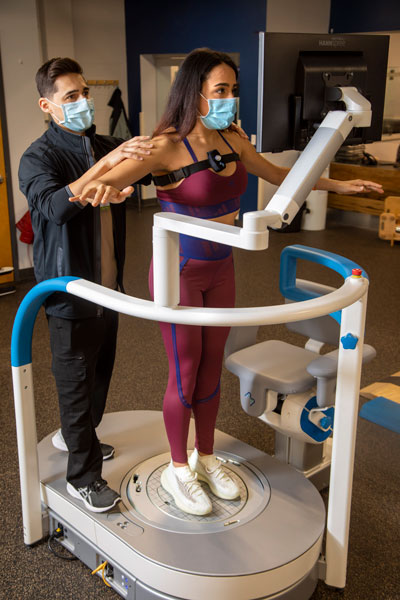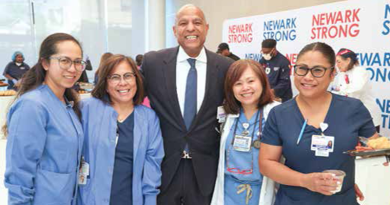Creating Balance between Medicine and Innovative Technology
Imagine experiencing tingling sensations and numbness in your legs, feet, arms and fingers with no clear indication of cause.
“It’s a scary feeling,” says 67-yearold Donna Fanelli, a River Edge, New Jersey, resident and patient at The Alfiero and Lucia Palestroni Foundation Multiple Sclerosis Center at Holy Name. She noticed these symptoms more than 17 years ago. “I went to several doctors before I was diagnosed with multiple sclerosis. And, honestly, I was relieved. I knew something was wrong but once I got the diagnosis, I asked, ‘what do I need to do to help myself?'”
Multiple sclerosis (MS) is an immune mediated disease in which the immune system attacks cells in the brain and spinal cord. An estimated 2.8 million people are living with this disabling neurological condition globally, and 200 new cases are diagnosed each year in the United States. MS attacks the central nervous system, disrupting the flow of information between the body and the brain, typically resulting in problems with vision, balance, coordination, walking, and memory.
“Receiving a diagnosis of a serious, chronic condition can feel as though you’ve been punched in the gut,” says Mary Ann Picone, MD, Medical Director of The Alfiero and Lucia Foundation Multiple Sclerosis Center at Holy Name. “Fortunately, we have cutting edge medications combined with advanced technologies to help treat the most complex cases.”

Palestroni Foundation Multiple Sclerosis
Center at Holy Name demonstrates the new
hunova technology, the latest equipment to
evaluate and treat patients who suffer from
balance difficulties caused by neurological
illness, injury and aging. Holy Name is the
only hospital in New Jersey to offer the
state-of-the-art device.
The most recent addition to Holy Name’s MS treatment arsenal is hunova, innovative technology that allows those living with MS to enhance their physical health by supporting physicians, physical therapists and patients to assess and restore balance. Holy Name is the only hospital in New Jersey to treat patients with hunova, which provides objective evaluation and treatment for individuals with balance difficulties caused by neurological illness, injury and aging. In addition to treating those living with MS, hunova can also be utilized by patients who struggle with balance due to orthopedic injuries and for patients with chronic neurological illnesses, such as Parkinson’s disease.
At Dr. Picone’s recommendation, Fanelli used the hunova technology at HNH Fitness in Oradell, which is home to the Holy Name Center for Physical Rehabilitation. “Using the hunova allowed me to use muscles that I don’t typically think about and helps people get stronger,” Fanelli says. “It puts you through a series of exercises that are randomized so that you don’t anticipate which muscles will kick in next. I recommend it for anyone whose mobility has diminished.” A second hunova machine at the Center for Physical Rehabilitation’s flagship location at Holy Name Medical Center in Teaneck will be installed shortly.
The hunova, created by Movendo Technology, is a programmable robotic medical device consisting of two force plates, one on the floor surface and one on an attached seat. These two force plates enable highly sensitive evaluation and active programming of resistance while both standing and sitting. The device can deliver more than 200 exercises for postural control, balance, and core stability.
For patients with orthopedic injuries, the hunova is used for the rehabilitation of the ankle, knee, hip and lumbar region of the spine, allowing the patient to perform mobilization exercises, muscle strengthening, and balance control. In the neurological arena, hunova is used for post-stroke functional reeducation, for the treatment of degenerative diseases of the central nervous system and lesions of the peripheral nervous system, providing exercises of postural control, balance and core stability.
“We’re pleased to add not one but two robotic devices to our arsenal of diagnostic, treatment and training tools,” says Reg Grant, the director of human performance at Holy Name. “Whether patients come to us for orthopedic rehabilitation or to regain balance due to a neurological illness, our commitment to offering the most advanced technology means that patients regain their confidence and get back on their feet quicker.”
Fanelli agrees. “There isn’t a cure for MS, but medication and technology may prolong my health and keep relapses at bay,” she says. “Balance is the key to all movement, and plays a critical role in my ability to successfully complete daily activities.” To learn more, go to holyname.org/MScenter


